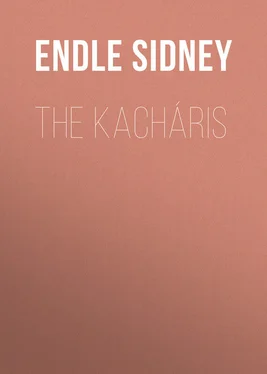Sidney Endle - The Kacháris
Здесь есть возможность читать онлайн «Sidney Endle - The Kacháris» — ознакомительный отрывок электронной книги совершенно бесплатно, а после прочтения отрывка купить полную версию. В некоторых случаях можно слушать аудио, скачать через торрент в формате fb2 и присутствует краткое содержание. Жанр: foreign_antique, foreign_prose, на английском языке. Описание произведения, (предисловие) а так же отзывы посетителей доступны на портале библиотеки ЛибКат.
- Название:The Kacháris
- Автор:
- Жанр:
- Год:неизвестен
- ISBN:нет данных
- Рейтинг книги:5 / 5. Голосов: 1
-
Избранное:Добавить в избранное
- Отзывы:
-
Ваша оценка:
- 100
- 1
- 2
- 3
- 4
- 5
The Kacháris: краткое содержание, описание и аннотация
Предлагаем к чтению аннотацию, описание, краткое содержание или предисловие (зависит от того, что написал сам автор книги «The Kacháris»). Если вы не нашли необходимую информацию о книге — напишите в комментариях, мы постараемся отыскать её.
The Kacháris — читать онлайн ознакомительный отрывок
Ниже представлен текст книги, разбитый по страницам. Система сохранения места последней прочитанной страницы, позволяет с удобством читать онлайн бесплатно книгу «The Kacháris», без необходимости каждый раз заново искать на чём Вы остановились. Поставьте закладку, и сможете в любой момент перейти на страницу, на которой закончили чтение.
Интервал:
Закладка:
The loom employed for weaving the eri silk is of very simple construction, and most, if not all, the material needed for the purpose can be provided by the villagers themselves from local resources.
The market value of a loom of this character is said to be about five rupees. It is usually set up on a shady side of the dwelling-house, or, where this is impracticable, a rude structure of thatch and bamboo work is provided to shield the weaver from the sun. The actual work is always carried out either by the lady of the house, or by one of her grown-up daughters; and it is in every way suitable to women workers, as it requires very little exertion of physical strength, but only a certain quickness and readiness of eye and hand. The conditions under which the industry is carried on are in all respects pleasing and satisfactory. Indeed, a Kachári woman working placidly and contentedly at the eri loom, singing quietly to herself in sheer happiness of heart, offers perhaps one of the most complete illustrations of the benevolent influence of the Pax Britannica to be found in the wide realm of India, especially when it is borne in mind that less than seventy years ago these Kachári Duars were subject to the Bhutan Rajas, who seem to have harried and plundered the people in the most cruel and lawless way. Soon after the master of the house, with one or more grown-up sons, has betaken himself to the rice-fields, and this he does almost at sunrise, his goodwife seats herself at the loom, and works away steadily until about 8 or 9 a.m., when she may be seen carrying a well-cooked and appetising meal, carefully shielded from rain and sun by plantain leaves, to her goodman, who from an early hour has been toiling in the fields for the good of the family. This duty discharged, she resumes her position at the loom for the greater part of what may remain of daylight. Immediately in front of the loom there are probably two or three small children (the Kachári race is a wholesomely prolific one) gambolling and tumbling over each other in high delight. To these the mother now and then devotes a word or two of remonstrance, whenever their gambols seem to threaten an infantile breach of the peace; and she may occasionally rise from her seat to administer some little corporal chastisement, though always “more in sorrow than in anger”; but otherwise she devotes herself steadily and assiduously to the work in hand. It is said that a Kachári woman, if not greatly or frequently interrupted in her work, can weave about half a yard each day; and, as this eri cloth, woven in long strips about two yards wide, can always command a ready sale at about Rs. 2/– per yard, it will be at once evident that a good worker can in this way, without neglecting other urgent domestic duties, easily make a substantial addition to the family income.
The fabric itself ( eri cloth), so produced, is one of great value, especially for use in the cold season, being at once soft and warm as well as remarkably strong and durable. Of its very great merit in this last-mentioned respect (durability) the writer has good reason to hold a very high opinion. Some twelve or fifteen years ago he was presented with a piece of eri cloth by one Leah Khángkhuáh, a good Kachári churchwoman, living not far from St. Paul’s Mission Church, at Bengbari, whose payment of her “Church dues” (tithe) took this very pleasing and highly practical form. The quantity of cloth given (the donor declined all money payment) was sufficient to make two ample bed-sheets, and in this character they have been in use now for at least a dozen years past. During that period they have of course been subjected to many and frequent barbarous washings; but even the rough treatment they have so often received at the hands of the Assamese dhobi has as yet failed to make any impression for injury on the warp and woof of this sound material; so substantial and conscientious is the work done by this good Kachári churchwoman and gentlewoman.
Position, social and domestic, of women. Among the Kacháris women do not perhaps occupy quite the same influential position as seems to be enjoyed by their sisters in the Khasi Hills, where something like a matriarchate apparently holds the field of social and domestic life. Still, with this interesting race the position of the wife and mother is far from being a degraded one. The Kachári husband and householder has neither sympathy with, nor tolerance for, that degrading and demoralising creed “which says that woman is but dust, a soul-less toy for tyrant’s lust.” On the contrary, he usually treats his wife with distinct respect, and regards her as an equal and a companion to an extent which can hardly be said to be the rule among many of the Indian peoples. Kachári women, both in early life and as matrons, enjoy a large measure of freedom, a freedom which is very rarely abused for evil purposes. On being spoken to on the wayside, the Kachári woman will generally reply at once with absolute frankness, looking the questioner straight in the face and yet with the most perfect modesty. It has often happened to the writer during the last forty years to enter a Kachári village for preaching purposes, or with a view to opening a school. On asking for the village headman, that personage is usually not slow in making his appearance; and after a few friendly words he will, quite as a matter of course, introduce his wife, and that with no small pride and pleasure. In discharging this social duty, he will very commonly use much the same language as may be heard among the working classes in England. The phrase most common is “Be áng-ni burui,” literally “This (is) my old woman.” The words are not used jeeringly at all, but with much real respect and affection; and are obviously so regarded by the speaker’s life-partner, whose face and features, somewhat homely in themselves, may often be seen to light up at once with a very pleased and pleasing smile on hearing herself thus referred to by the sharer of her life’s joys and sorrows. There is, too, another consideration, not perhaps altogether unknown in other parts of the world, which has great weight with the Kachári paterfamilias, viz., that his goodwife for the most part does not a little to provide for the family needs in the matter of food and raiment. Her prowess at the loom has been mentioned before; and besides this, the actual planting out of the young rice-seedlings is for the most part carried through by the women. And all this is habitually done without in any way neglecting or slurring over the usual duties more strictly appropriate to the goodwife and mother.
On the whole it may perhaps be safely said that the social and domestic life of the Kachári is not without its pleasing and satisfactory features. It is probably for the most part far sounder and more wholesome than the life of great cities, whether in Asia or Europe; and it is with no little dismay and sorrow that the writer would see any hasty ill-considered attempts made to supplant or override this simple, primitive, patriarchal life through the introduction of a one-sided, materialistic civilisation.
SECTION III
Laws and Customs
Internal Organisation. From such information as is available at the present day it a seems fairly clear that the internal and tribal organisation of the Kachári (Bara) race rested in early days, very largely at least, on a totemistic basis, although it is only here and there that any real regard for the totems can still be said to survive. In primitive days these subdivisions, all at one time strictly endogamous, 12 12 On this point Col. Gurdon, Hon. Director of Ethnography, Assam, writes as follows: – “I entertain grave doubts as to the correctness of the author’s remark that the Kachári totemistic clans were originally endogamous. If it had not been for the most unfortunate death of the author before this work went to press, we might have hoped to have had some light on this obscure point. Amongst the Mech, who are the first cousins of the Kacháris, and who live alongside of them, marriage is exogamous, vide page 124 of the Monograph, so also amongst the Garos, who may be described as second cousins of the Kacháris. Mr. Friel, Sub-Divisional Officer of Mangaldai, which division of the Darrang district contains a large number of Kacháris, met an old Kachári who stated quite positively that ‘before the Dewangari war, Kacháris were not allowed to marry within their own sub-tribe.’ It is true that Mr. Friel’s informant afterwards contradicted himself, but I think it is quite possible his first statement was the correct one. On the other hand, it should be stated in favour of Mr. Endle’s theory that three men were found in Sekhar mauza of Mangaldai who stated that in former days ‘a penance had to be performed if one married outside one’s own kur .’ My own view, however, is that stated above, and I do not think the statement that the Kachári totemistic clans were endogamous should be accepted without further investigation.”
Интервал:
Закладка:
Похожие книги на «The Kacháris»
Представляем Вашему вниманию похожие книги на «The Kacháris» списком для выбора. Мы отобрали схожую по названию и смыслу литературу в надежде предоставить читателям больше вариантов отыскать новые, интересные, ещё непрочитанные произведения.
Обсуждение, отзывы о книге «The Kacháris» и просто собственные мнения читателей. Оставьте ваши комментарии, напишите, что Вы думаете о произведении, его смысле или главных героях. Укажите что конкретно понравилось, а что нет, и почему Вы так считаете.











